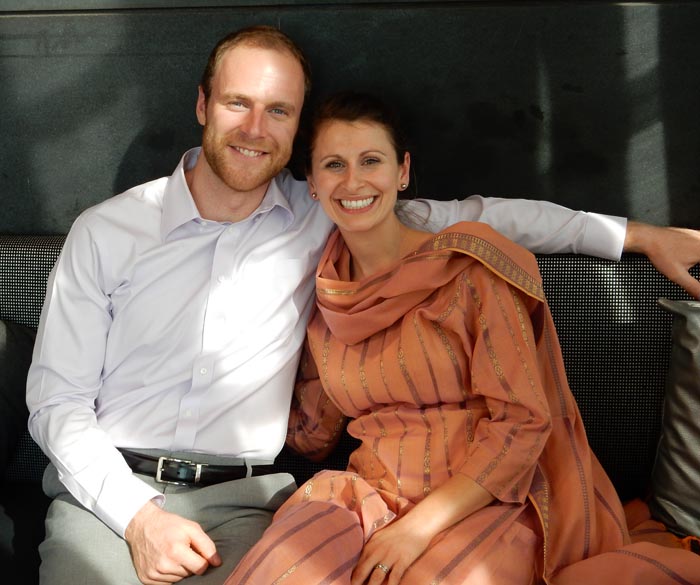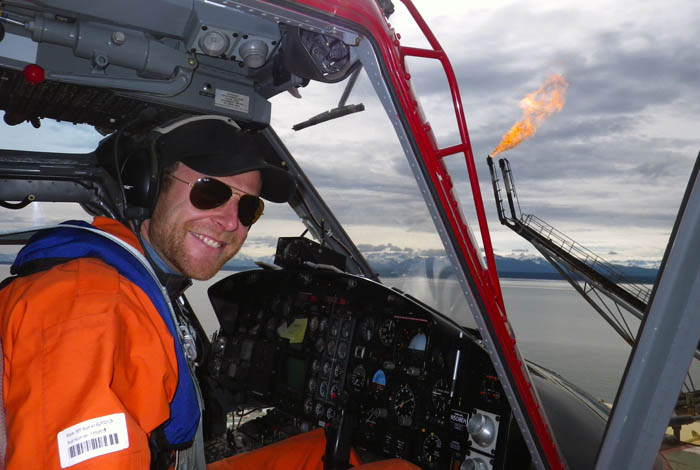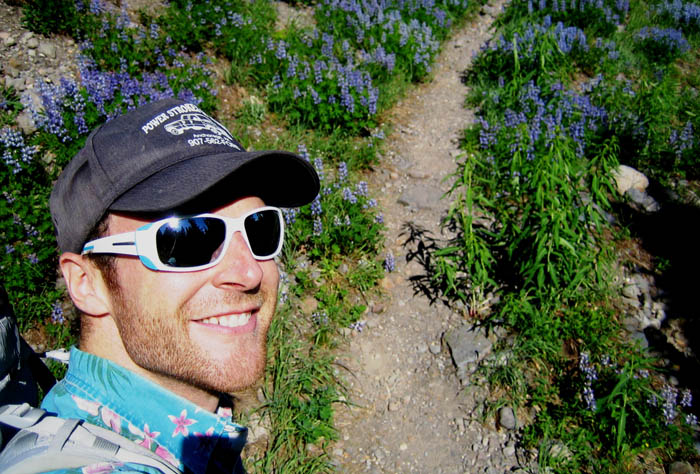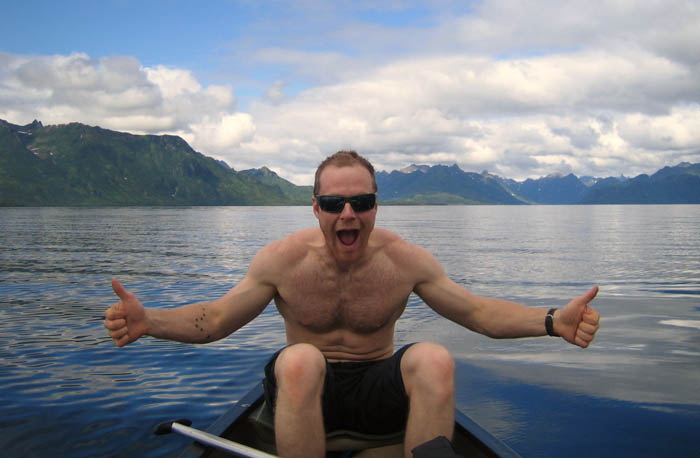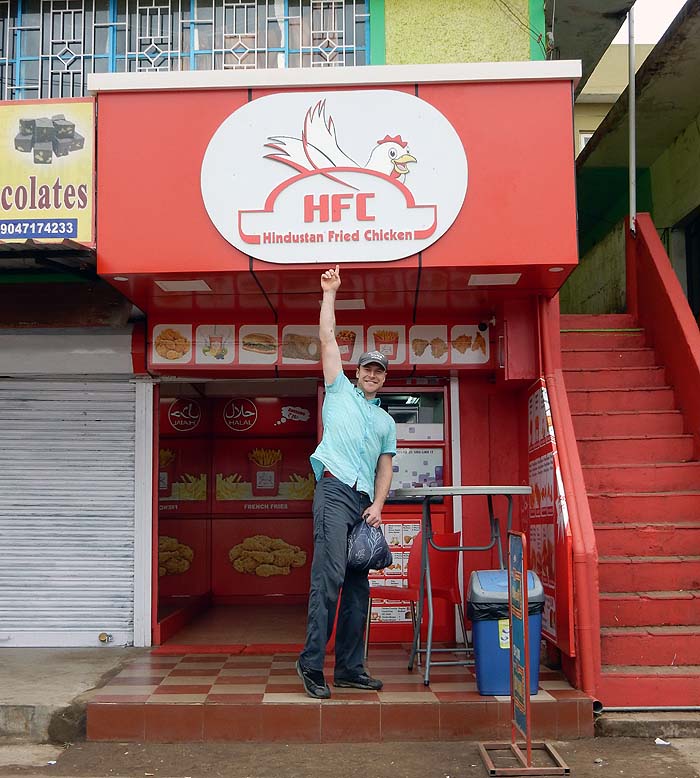Mountain Trip seeks the best guides in the business. Our guides are well traveled, highly knowledgeable, professional and awesome people. But, don’t take it from us, get to know our guides for yourself! Nick Shepherd joined the Mountain Trip family in 2006 and epitomizes the adventurous spirit of the guiding life. Nick packs a lot into his year, traveling, climbing, guiding and flying high tech whirlybirds. I may never understand the latter passion, but I recently sat down with Nick and sure tried…
TR: Why did you choose to become a Mountain Guide?
NS: In seventh grade, I was strapping my Sorel snow boots into an old Morrow snowboard and shredding the bunny slopes in Anchorage. Meanwhile, my older brother was introducing me to climbing at the local gym and telling me climbing stories about his ueber-cool sounding buddy. That friend starting guiding for Mountain Trip and so began the dream for me. I knew that if my idols were guides, I wanted to be one too.
TR: What relevant experience did you have when you started guiding?
NS: Growing up in Alaska, I was exposed to the outdoors in all seasons and many sport regimens. Hiking led to backpacking, to climbing, to skiing, to ice climbing, to alpine. Before I knew it, I’d spent ten years making mistakes in the mountains and learning from them. On my twenty-third birthday, I’d made it; I was working as an apprentice on Denali, learning from some of the best guides around.
T: What sort of courses, education or certifications have you taken along the way?
NS: My guide training has consisted primarily of apprenticeships, working under guides with decade of experience. In addition, I have undergone wilderness medical certification, guide training workshops through Mountain Trip, avalanche training, and weather analysis/forecasting. My work as a helicopter pilot has led to crossover skills that include training in high altitude physiology, mountain specific weather, team management, and systematic risk evaluation.
TR: For how long and where have you guided?
NS: Seven golden years have slipped by as a guide. I cut my teeth on Denali over and over (I’ve been on that fantastic mountain many times). However, I have mixed it up with a trip in the Cascades, and this winter, an incredible trip down to Aconcagua. Talk about a land of beautiful places, people, food, and wine……. with some big mountain climbing sprinkled in, of course.
TR: If guiding is not your only source of income, what else do you do to make ends meet?
NS: Guiding has dovetailed nicely with my work as a helicopter pilot. I’ve worked as a flight instructor, offshore oil pilot, and will be flying tours in Alaska this summer. Both jobs put me in amazing environments, but it’s a little easier to adjust the heat and stay dry with an eighth inch of plexiglass between myself and the elements. The flip-side is that I have a harder time justifying 4000 delicious calories of food a day when there’s no pack on my back.
TR: What was your first concert? (Props to Lucky Lindy for this question!!!)
NS: Live – Smashing Clay tour, baby! I saw them in sixth grade with a group of the “cool” kids. We thought we were cool but were, in fact, big dorks. After the concert, a girls father thought it’d be impressive if the boys could lift up his old VW bug. With ten of us on the case, the car still wouldn’t move an inch. I still laugh, thinking about that night.
TR: What is the most rewarding part of the job?
NS: There’s nothing like watching climbers push to their limit, then excel beyond it. Those experiences help expedition climbing foster a sense of immediate community that would otherwise take years to develop. I love being a part of that experience, and it certainly doesn’t hurt that I get to see it in the middle of remote mountains.
TR: What is one of the greatest challenges of the job?
NS: For me, the hardest part of guiding is saying “no”. Every trip, there are times when that word must be said, but it doesn’t make it any easier. Sometimes the weather mandates it, sometimes the limits of packable weight dictate things, and on occasion team strength may be maxed out. To make “no” an acceptable and understandable necessity, I work to build team trust and reliability quickly. Then, if a “no” must be said, climbers understand I’m making the decision for important reasons.
TR: What are your goals in the profession?
NS: I want to continue guiding more international destinations and would really like to begin working some ski touring/mountaineering trips. To continue honing my guide skills, I also look forward to attending more guide training courses, always increasing my skill-set.
TR: How do you train / keep your skills fresh?
NS: I’m an exercise junkie, plain and simple. Wherever I am, whatever outdooor sports are available, you can count me in. My favorite thing to do is to find someone better than I am at any individual activity, be it tennis, climbing, skiing, running, packrafting, bicycling etc. and then use their skills as a competitive challenge to push myself. The tie that binds, however, is yoga. I’m on my mat four days a week. For four years now it’s been the best way to get stronger, more flexible, and mentally relaxed.
TR: How do you return to the same venue over and over, yet still keep it fresh for your clients?
NS: There’s no replacement for good people and good food. Also, after a few trips on a mountain, I’m able to begin focusing on small details that might not otherwise get the attention when I’m busier. It may be a new serac feature, historical fact, perfectly crafted kitchen, or well-timed corny joke. Another way I try to keep things fresh is by doing laundry between trips. It makes one heck of a difference…
TR: How do you manage risk on big, cold mountains? If this is too vague, maybe give me one instance of how you managed risk on a recent trip.
NS: I’d like to quote a favorite textbook of mine that sums risk management up nicely in one statement, describing sound decision making as a “systematic approach to the mental process of evaluating a given set of circumstances and determining the best course of action.”
This often means taking a few extra moments to breathe deep, relax, and think about the task at hand before beginning. I’ve lost count of the number of times the technique has helped me work through a difficult situation safely and efficiently. I also have a few very educational memories of when I didn’t employ the technique and made mistakes as a result. Even the most mundane, simple tasks in the mountains deserve due diligence.
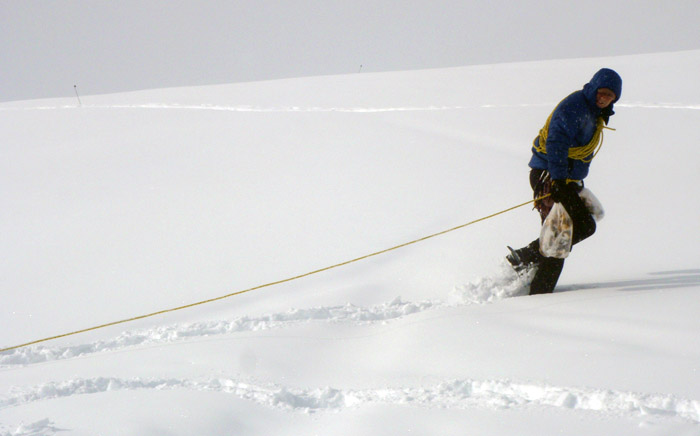
Guiding is not always glamorous… Nick heading for a deep crevasse to “take care of the team’s business.”
TR: Do you have any tips or advice for people who are considering climbing a big, cold mountain? Give us one specific thing that you do to take care of yourself in an unforgiving environment.
NS: When going big and going cold, train like mad. Get your body strong, your mind sharp, and your emotional state into a Bhudda-like sense of calm. Arrive over-prepared physically and relaxed mentally. You’ll set yourself up for success on the mountain, regardless of whether it means hauling your big pack for a long push, or re-reading “Ivanhoe” in a tent for days, waiting out a storm. Get that beach body ready, then laugh when you head to the mountains and hide it under many layers of good insulation.
TR: What do you do for fun in your spare time?
NS: Spare time, what spare time? Seriously, though, one of my favorite spare time activities is to go eat great food around Portland, OR with my fiance (yup, I’m getting married this fall, it’s going to be great!).
TR: Who is you favorite boss? 😉
NS: Laura is my favorite boss because she’s queen bee. After that, who can resist the tag-team, Bill and Todd. I think of you as the Ultimate Warrior and Rowdy Rod Piper.
[/vc_column_text][/vc_column][/vc_row]

